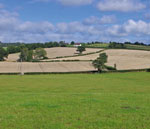Farmland prices rise
English farmland values rose by 3.2% in the third quarter of 2009, the second successive quarterly increase


The average price of farmland in England is now £4973/acre, just £125/acre below its summer 2008 peak. Prices, however, remain variable with the best land achieving a significant premium, says research from Knight Frank.
Andrew Shirley, head of rural land research, says: 'Over the past 15 years farmland has performed significantly better than residential property and the FTSE 100 index.
'Although commodity prices have fallen back significantly from last year's record highs, there seems to be a feeling that agriculture in the UK has a long-term future and farmers, who make up 57% of buyers, are keen to buy more land. We are also seeing tentative signs of a return of the lifestyle buyer (25% of purchasers) as the housing market starts to pick up again.'
Notable in their absence have been overseas buyers who were significant players prior to the credit crunch, especially the Irish and Danish. This is despite the fall in the value of sterling, making purchases considerably cheaper for Euro-based buyers.
Supply of land also remains limited with about 15% fewer acres available for sale this year than last. There have been few forced sales as banks remain generally supportive of agriculture. Lenders are also offering attractive long-term finance rates to those looking to expand which is helping to support prices.
'The market, however, is more selective than it was during the first half of 2008 when even fairly average blocks of land were achieving exceptional prices,' says Mr Shirley. 'Farmers will pay good prices for land, but only if it is of the right quality in the right location. Some recent sales have made over £7000/acre, while less desirable land is proving more difficult sell.
'We expect growth to continue for the rest of 2009 and into 2010, although, as usually happens, the market could become more tentative in the run up to the general election, widely predicted to be held next May. Commodity prices may have fallen back in the short term, but global cereal stocks remain historically low and demand will start to increase again as the world edges out of recession over the next few years.'
Exquisite houses, the beauty of Nature, and how to get the most from your life, straight to your inbox.

